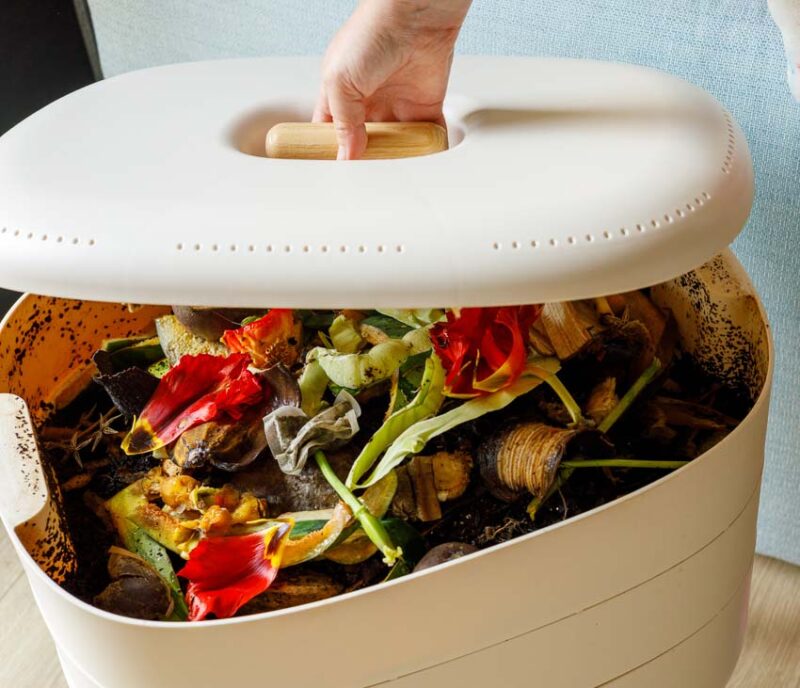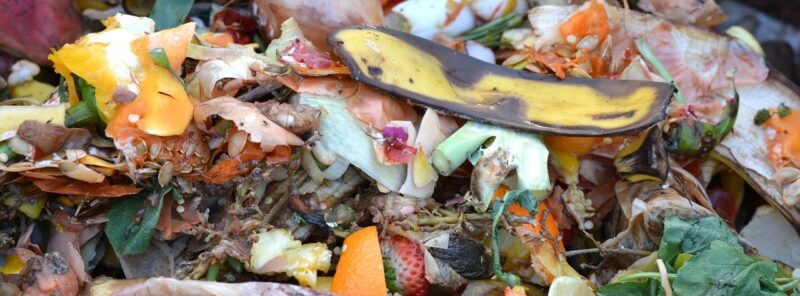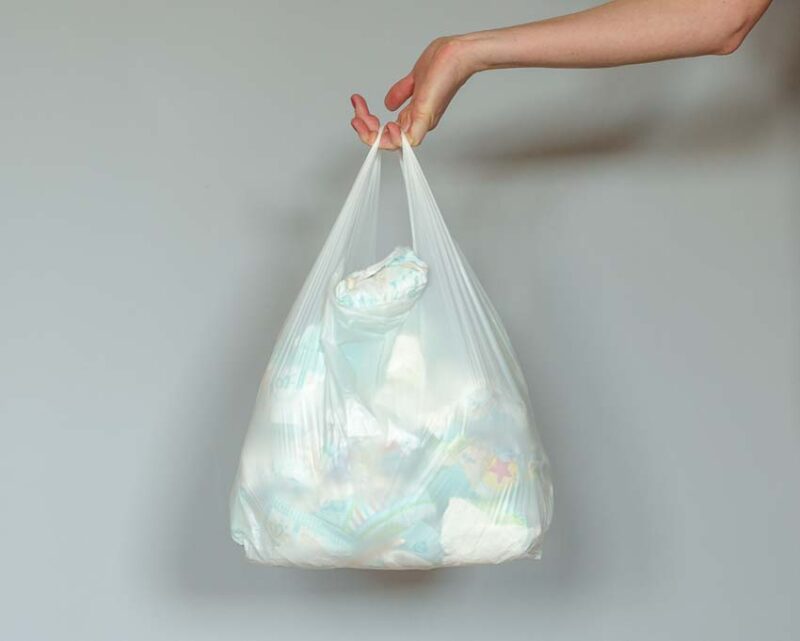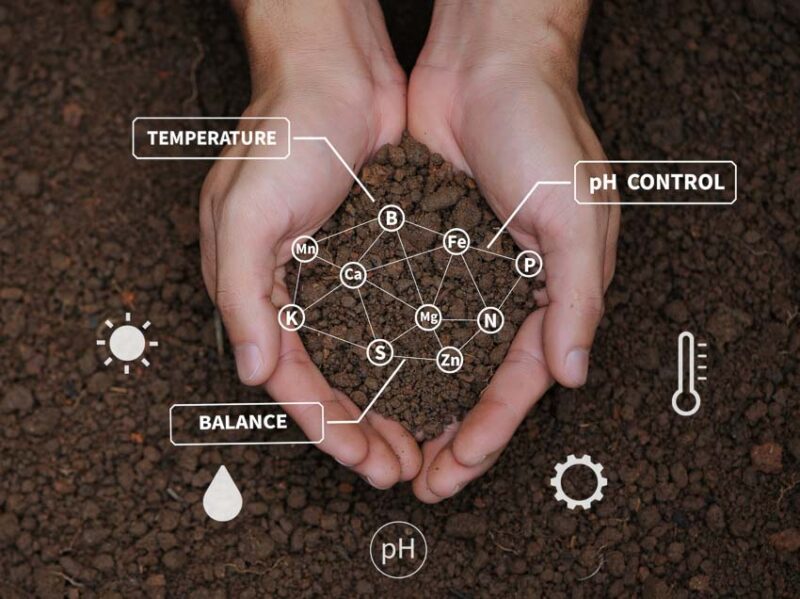Composting is the process of converting organic waste, such as food scraps and yard debris, into a nutrient-dense fertilizer for your garden. If you’ve been wanting to learn how to start composting, this guide will be a great jumping-off point! Composting is one of the best things you can do for healthy plants and the environment. We’re going over the basics of composting so you can get started recycling your organic waste into “black gold” for your garden!
Benefits of Composting
Composting provides several benefits, including the following:
- Improves soil structure and texture
- Reduces the amount of waste sent to landfills by up to 30%
- Helps plants withstand diseases, pests, and drought conditions better
- Suppresses plant diseases and harmful soil fungi when added to garden beds.
- Reduces or eliminates the need for chemical fertilizers
- Improves soil drainage and aeration for healthier root systems.
- Reduces soil erosion and runoff when added to garden beds.
- Saves money since you can make compost at home for free.
- Creates a natural fertilizer that doesn’t contain chemicals found in many store-bought plant foods.
Composting Methods
There are a few different methods you can use to compost at home. Below, we’ll go over the basic methods to get started composting.
Compost Bin or Pile

A compost bin or pile involves placing organic composting materials into an open pile or bin, as you would expect. This process requires you to periodically turn and mix the pile to ensure it receives proper aeration as it breaks down. You can use a bin to keep the pile neat, while also retaining heat and moisture. You can either purchase a compost bin from your local garden center, or go the DIY route using your own materials like wood, wire mesh, and plastic.
To start using this method, create a 4 to 5-foot wide base of brush or woodchips to allow for air circulation under your material. Add composting materials on top to create your pile. Every 7 to 10 days, turn and mix your pile with a pitchfork. Usable compost will result in around 2 to 3 months.
Tumbler Composter
For an easier, quicker composting method, you can also use a tumbler composter. These are closed drums that sit on an elevated stand. Load your compost materials through an opening, and then turn or “tumble” the drum periodically, aerating your compost. These enclosed drums retain heat and moisture well.
In some cases, this method can process compost material faster, in as little as 2 to 4 weeks. One drawback, however, is size. Capacity is more limited compared to open piles and bins.
Vermicomposting

Vermicomposting involves utilizing red wiggler worms to break down your organic matter into compost. To use this method, house worms in bins with bedding and feed them food scraps. In turn, the worms will produce castings, which are full of nutrients for your garden.

Vermicomposting produces compost in 2 to 3 months in the right moisture and supply conditions. This method is ideal for homes with limited space, however, it’s important to keep the worms healthy to produce your compost.
Hot Composting
One of the fastest compost methods, hot composting involves building a large pile of at least 3x3x3 feet. When you mix a proportion of carbon and nitrogen-rich materials, it generates heat which speeds up decomposition. Use a pitchfork to stir the pile ever day to dissipate heat and redistribute materials.
The high temperatures produced by hot composting will kill pathogens and weed seeds. You’ll start to have usable compost in just 4 to 6 weeks with this method, although you need to monitor it and turn your material more frequently.
Trench/Sheet Composting
One of the easiest methods of composting is trench/sheet composting. This method involves burying kitchen scraps and other organic compostables directly in your garden beds. To start this method, dig trenches 8 to 12 inches deep in your garden bed and mix your scraps with soil. Bury this mixture around 4 inches below the surface.
Over the next 2 to 3 months, this material will compost and provide nutrients to your plants directly through the soil. You can also bury your compost under sheets of cardboard or newspaper to lock in moisture.
Things You Should Compost

There are a number of items that you probably use or produce frequently that are perfect for composting. These include:
- Fruit and vegetable peels, skins, and scraps
- Coffee grounds and tea bags
- Eggshells
- Shredded newspaper
- Cardboard boxes and toilet paper tubes
- Paper towels and napkins
- Cotton and wool rags
- Dryer and vacuum cleaner lint
- Hair and fur
- Grass clippings
- Leaves, straw, and garden debris
- Wood chips, sawdust, and shavings
- Hay and alfalfa meal
- Branches, twigs, and small sticks broken into pieces
To speed decomposition, you can also shred or chop large pieces and moisten dry materials like paper or leaves when you add them to your pile.
Things You Should Not Compost

While it’s true that most organic waste breaks down well, there are items to avoid adding to your compost. These include:
- Meat, fish, bones, or dairy products, which can attract pests
- Grease, oil, or butter-containing foods
- Pet or human waste (feces, litter, diapers)
- Invasive weeds or noxious plant clippings, as seeds may survive and spread
- Diseased plant materials
- Sawdust, leaves, grass, or yard waste from chemically treated lawns or gardens
- Charcoal ash, coal, or briquettes
- Non-biodegradable materials like plastic or synthetic fibers
Anything containing animal products, chemicals, or synthetic materials can’t be broken down. You should dispose of anything listed above with your regular waste.
Understanding Carbon to Nitrogen Ratios in Composting
One of the most important and fundamental aspects of successful composting is understanding and managing the carbon-to-nitrogen ratio. This is the backbone that ensures an active and vibrant microbial community to facilitate a rapid (and odor-free) decomposition process.
Carbon is the energy source, and nitrogen is the building block for microbial growth. Both elements work harmoniously to break down organic matter into a nutrient-rich soil additive.
The Significance of Carbon and Nitrogen

Microorganisms such as bacteria, fungi, and protozoa, along with larger organisms like earthworms and insects, facilitate the decomposition process in a compost pile. These organisms feed on the organic matter in your compost and break it down into simple substances.
Carbon is a primary energy source for these organisms, and nitrogen is essential for their growth and reproduction.
It’s very important to maintain the right balance of carbon and nitrogen for a quick and odor-free composting process. A good rule of thumb is to stick to a carbon:nitrogen ratio of around 25-30:1. This level ensures an ideal environment conducive to microbial activity. It also prevents issues like unpleasant smells, pests, and slow decomposition.
Carbon-Rich “Brown” Materials
Carbon-rich materials, such as dry leaves, paper, cardboard, and sawdust, are often referred to as “browns” in composting. Browns are high in carbon and low in nitrogen, providing your compost with a loose structure that enables aeration. A loose structure helps you avoid pile compaction, which can slow down the decomposition process.
Using the right amount of browns in your pile helps you achieve a fluffy, aerated compost collection. It also aids in preventing anaerobic conditions that cause foul smells and ineffective composting.
Nitrogen-Rich “Green” Materials
The other part of your composting equation is the nitrogen-rich or “green” side. These materials include grass clippings, and kitchen scraps, such as fruit peels, vegetable scraps, and coffee grounds. Green materials are high in nitrogen and low in carbon, contributing to the growth and reproduction of the microbial organisms in your compost pile.
Even though these materials are important for a healthy compost pile, using too many can produce a slimy, smelly compost. Balance is key, so make sure you’re using the right ratio of greens to browns for a healthy composting process.
Achieving the Ideal Carbon:Nitrogen Ratio
The right C:N ratio is more of an art than an exact science. You have to gauge the types and quantities of materials you add to your compost pile adjusting as needed. While you should aim for an ideal ratio of around 25-30:1, anywhere in the range between 20:1 to 40:1 will still yield good results in most cases. This range ensures your composting process will be efficient, and avoid the risk of a hostile environment for microbial life.
To maintain the right balance, you have to continually adjust your material additions. Add more browns if your pile becomes too wet or starts to smell, and add more greens if decomposition seems to stall.
Adjusting C:N Ratios
Achieving the ideal C:N ratio can seem like chasing a moving target, especially since different materials have different ratio needs. For example, sawdust has a C:N ratio of around 500:1, while vegetable scraps have a much lower ratio.
The key lies in understanding the inherent C:N ratios of a variety of materials and adding them in appropriate proportions for a balanced pile. You may find that it requires a fair bit of trial and error, but you’ll soon develop a sense of what you need.
Monitoring and Maintaining Your Compost Pile
Not only will a well-maintained compost pile exhibit a healthy decomposition process, but it will also ward off pests and prevent foul odors. It’s important to regularly turn your pile to ensure even decomposition levels, as well as avoid hot spots and aid in aeration.
One way to manage the health of your compost pile is to monitor its temperature. Aim for a temperature level of between 130°F -160°F (55-70°C), which is the ideal range for microbial activity and for killing weed seeds and pathogens.
As you get ready to start your composting journey, remember that patience is a great asset. For a successful composting pile, you need to nurture an entire living ecosystem that, when well-maintained, can transform common organic waste into “black gold” for your garden. Now, go forth and compost!
FAQs About How to Compost
What is the ideal carbon-to-nitrogen ratio for compost?
The ideal carbon:nitrogen ratio is around 25-30:1. This ratio fosters an environment conducive to microbial activity, which helps your material decompose more quickly. A balanced ratio ensures that your pile does not emit foul odors, and will break down matter into nutrient-rich compost for your garden.
What materials provide carbon vs. nitrogen?
Carbon-rich materials, often called “browns,” include materials like dry leaves, straw, paper, and cardboard. Nitrogen-rich materials are known as “greens,” and include kitchen scraps, like veggie peels, fruit scraps, and grass clippings. A balanced ratio of browns and greens helps you achieve the ideal ratio for a healthy compost pile.
How do I know when compost is ready to use?
Compost is ready to use when it attains a soil-like texture, dark color, and pleasant, earthy smell. You should not be able to recognize any individual organic materials, and your compost should be cool to the touch.
Usually, this process takes between 2 and 4 months, depending on your conditions and methods/materials used. Be sure your pile is fully decomposed before you add it to your soil to provide the optimum nutrient levels.
What particle size should I break compost materials into?
You can break down your composting materials into smaller pieces, around 1 to 2 inches in size, to promote faster decomposition. This increases the surface area for microbial activity, as well as allowing for better aeration and moisture retention.
How do I maintain the right moisture level?
Your compost pile’s moisture level should feel about as damp as a wrung-out sponge. If your pile is too dry, gradually add water. If it’s too wet, add dry, carbon-rich browns. The goal is to maintain a good moisture level without waterlogging your compost, which can lessen the efficiency of decomposition.
How often should I turn and mix the compost?
Most compost piles should be turned regularly every 3 to 7 days to promote adequate aeration and even decomposition. Regularly turning your compost helps to distribute heat evenly throughout your pile, preventing foul odors and creating a beneficial microbial environment.
How do I prevent unpleasant odors from the compost?
Compost can develop an unpleasant odor when the carbon:nitrogen ratio is off-balance or when the moisture levels are wrong. To combat this, add the correct levels of browns and greens and turn your pile regularly to promote proper aeration. Avoid adding things like diseased plants, dairy, meats, and oily foods, which can produce smells and attract pets.
What size and type of compost bin do I need?
Your ideal size of compost bin will depend on the amount of compostable waste your household generates, as well as your available space. For a standard house, a common-size compost bin would be around one cubic card. Bins can be either open or closed, with closed bins being favorable for smaller spaces due to better odor and pest management.
Where is the best location to compost?
The best composting location is one that is level, well-drained, and accessible. It should receive a good amount of sunlight to maintain optimum temperatures for decomposition. You should also keep it in an area that’s convenient for adding materials to the bin.
How do I compost in winter?
Composting in winter can be achieved by insulating your compost pile with a thick layer of browns, like straw or leaves. This process protects your pile from freezing temperatures. Maintaining a large compost pile can help retain heat, and turning your pile occasionally can help distribute the moisture and heat levels during the winter.
What are the small white bugs in my compost?
If you’re seeing small, white bugs in your compost, they’re likely springtails. These bugs are harmless and even benefit the decomposition process. They feed on decomposing matter, which helps break down your material into nutrient-rich compost.



